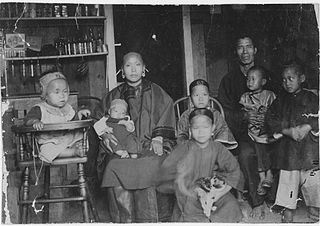| Part of a series on the |
| Anthropology of kinship |
|---|
 |
| Social anthropology Cultural anthropology |
The Burmese kinship system is a fairly complex system used to define family in the Burmese language. [1] In the Burmese kinship system: [2]
| Part of a series on the |
| Anthropology of kinship |
|---|
 |
| Social anthropology Cultural anthropology |
The Burmese kinship system is a fairly complex system used to define family in the Burmese language. [1] In the Burmese kinship system: [2]
Many of the kinship terms used in Burmese today are extant or derived from Old Burmese. [3] These include the terms used to reference siblings and in-laws. [3]
The Burmese kinship system identifies and recognizes six generations of direct ancestors, excluding the ego: [4]
The Burmese kinship system identifies seven generations of direct descendants, excluding the ego: [4]
Kinship terms differ depending on the degree of formality, courtesy or intimacy. Also, there are regional differences in the terms used.
Burmese also possesses kin numeratives (in the form of suffixes):
The Burmese kinship system also recognizes various relationships between family members that are not found in English, including: [4]
| Relation | Term | Form of address | English equivalent | Notes |
|---|---|---|---|---|
| Father | ဖခင် pha khin | အဖေa phay ဖေဖေphay phay | Father | |
| Mother | မိခင် mi khin | အမေa may မေမေmay may | Mother | |
| Elder brother (male ego) | နောင် naung | Brother | ||
| Elder brother (female ego) | ကို ko | Brother | ||
| Younger brother (male ego) | ညီ nyi | Brother | ||
| Younger brother (female ego) | မောင် maung | Brother | ||
| Older sister | မ ma | Sister | ||
| Younger sister (male ego) | နှမ hna ma | Sister | ||
| Younger sister (female ego) | ညီမ nyi ma | Sister | ||
| Husband | လင် lin | Husband | Informal: ယောက်ျား (yaukkya). Formal: ခင်ပွန်း (khinbun). | |
| Wife | မယား maya | Wife | Informal: မိန်းမ (meinma). Formal: ဇနီး (zani). | |
| Son | သား tha | Son | ||
| Daughter | သမီး thami | Daughter |
| Immediate lineage | ||||
|---|---|---|---|---|
| Relation | Term | Form of address | English equivalent | Notes |
| Parent's father | ဖိုး pho | Grandfather | ||
| Parent's mother | ဖွား phwa | Grandmother | ||
| Father's elder brother | ဘကြီး ba gyi | Uncle | ||
| Father's younger brother | ဘလေး ba lay | Uncle | The youngest uncle may be called ဘထွေး (ba dway). | |
| Father's elder sister | အရီးကြီး ayi gyi | Aunt | ||
| Father's younger sister | အရီးလေး ayi lay | Aunt | The youngest aunt may be called ထွေးလေး (dway lay). | |
| Mother's elder brother | ဦးကြီး u gyi | Uncle | ဝရီး (wayi) is now obsolete. | |
| Mother's younger brother | ဦးလေး u lay | Uncle | ||
| Mother's elder sister | ဒေါ်ကြီး daw gyi | Aunt | Also ကြီးတော် (kyidaw). | |
| Mother's younger sister | ဒေါ်လေး daw lay | Aunt | The youngest aunt may be called ထွေးလေး (dway lay). | |
| First cousin | မောင်နှမ တဝမ်းကွဲ maung hnama ta wun gwe | First cousin | Lit. "siblings one womb removed" | |
| Nephews and nieces | ||||
|---|---|---|---|---|
| Relation | Term | Form of address | English equivalent | Notes |
| Sibling's son | တူ tu | Nephew | ||
| Sibling's daughter | တူမ tuma | Niece | ||
| In-laws | ||||
|---|---|---|---|---|
| Relation | Term | Form of address | English equivalent | Notes |
| Brother's wife (female ego) Husband's sister | ယောက်မ yaungma | sister-in-law | ||
| Elder brother's wife (male ego) Wife's elder sister | မရီး mayi | sister-in-law | ||
| Younger brother's wife (male ego) Wife's younger sister | ခယ်မ khema | sister-in-law | ||
| Sister's husband Husband's younger brother Wife's brother | ယောက်ဖ yaukpha | brother-in-law | ||
| Elder sister's husband (female ego) Husband's elder brother | ခဲအို khe-oh | brother-in-law | ||
| Younger sister's husband (female ego) Husband's younger brother | မတ် mat | brother-in-law | ||
| Son's wife | ချွေးမ chwayma | daughter-in-law | ||
| Daughter's husband | သမက် thamet | son-in-law | ||
| Spouse's father | ယောက္ခထီး yaukkahti | father-in-law | ||
| Spouse's mother | ယောက္ခမ yaukkhama | mother-in-law | ||

An aunt is a woman who is a sibling of a parent or married to a sibling of a parent. Aunts who are related by birth are second-degree relatives. Alternate terms include auntie or aunty. Children in other cultures and families may refer to the cousins of their parents as aunt or uncle due to the age and generation gap. The word comes from Latin: amita via Old French ante and is a family relationship within an extended or immediate family.
The Serbo-Croatian standard languages have one of the more elaborate kinship (srodstvo) systems among European languages. Terminology may differ from place to place. Most words are common to other Slavic languages, though some derive from Turkish. The standardized languages may recognize slightly different pronunciations or dialectical forms; all terms are considered standard in all language standards, unless otherwise marked: [S] (Serbian), [C] (Croatian), [B] (Bosnian) and [M] (Montenegrin) below.
Iroquois kinship is a kinship system named after the Haudenosaunee people, also known as the Iroquois, whose kinship system was the first one described to use this particular type of system. Identified by Lewis Henry Morgan in his 1871 work Systems of Consanguinity and Affinity of the Human Family, the Iroquois system is one of the six major kinship systems.
Eskimo kinship is a category of kinship used to define family organization in anthropology. Identified by Lewis H. Morgan in his 1871 work Systems of Consanguinity and Affinity of the Human Family, the Eskimo system was one of six major kinship systems. The system of English-language kinship terms falls into the Eskimo type.
Hawaiian kinship, also referred to as the generational system, is a kinship terminology system used to define family within languages. Identified by Lewis H. Morgan in his 1871 work Systems of Consanguinity and Affinity of the Human Family, the Hawaiian system is one of the six major kinship systems.
Omaha kinship is the system of terms and relationships used to define family in Omaha tribal culture. Identified by Lewis Henry Morgan in his 1871 work Systems of Consanguinity and Affinity of the Human Family, the Omaha system is one of the six major kinship systems which he identified internationally.
Sudanese kinship, also referred to as the descriptive system, is a kinship system used to define family. Identified by Lewis Henry Morgan in his 1871 work Systems of Consanguinity and Affinity of the Human Family, the Sudanese system is one of the six major kinship systems.
A cousin is a relative that is the child of a parent's sibling; this is more specifically referred to as a first cousin.

Dameli (دَميلي), also Damia, Damɛ̃ḍī, Dāmia bāṣa or Gidoj, is an Indo-Aryan language of the Dardic subgroup spoken by approximately 5,000 people in the Domel Town, in the Chitral District of Khyber-Pakhtunkhwa province of Pakistan.

The Chinese kinship system is among the most complicated of all the world's kinship systems. It maintains a specific designation for almost every member's kin based on their generation, lineage, relative age, and gender. The traditional system was agnatic, based on patriarchal power, patrilocal residence, and descent through the male line. Although there has been much change in China over the last century, especially after 1949, there has also been substantial continuity.
In general, a Vietnamese pronoun can serve as a noun phrase. In Vietnamese, a pronoun usually connotes a degree of family relationship or kinship. In polite speech, the aspect of kinship terminology is used when referring to oneself, the audience, or a third party. These terms may vary by region. Many are derived from Chinese loanwords but have acquired the additional grammatical function of being pronouns.
Kinship terminology is the system used in languages to refer to the persons to whom an individual is related through kinship. Different societies classify kinship relations differently and therefore use different systems of kinship terminology; for example, some languages distinguish between consanguine and affinal uncles, whereas others have only one word to refer to both a father and his brothers. Kinship terminologies include the terms of address used in different languages or communities for different relatives and the terms of reference used to identify the relationship of these relatives to ego or to each other.

Family is a group of people related either by consanguinity or affinity. It forms the basis for social order. Ideally, families offer predictability, structure, and safety as members mature and learn to participate in the community. Historically, most human societies use family as the primary purpose of attachment, nurturance, and socialization.
Philippine kinship uses the generational system in kinship terminology to define family. It is one of the most simple classificatory systems of kinship. One's genetic relationship or bloodline is often overridden by the desire to show proper respect that is due in the Philippine culture to age and the nature of the relationship, which are considered more important.
In the lineal kinship system used in the English-speaking world, a niece or nephew is a child of an individual's sibling or sibling-in-law. A niece is female and a nephew is male, and they would call their parents' siblings aunt or uncle. The gender-neutral term nibling has been used in place of the common terms, especially in specialist literature.
Irish kinship is a system of kinship terminology which shows a bifurcate collateral pattern. This system is used by a minority of people living in the Gaeltacht regions of Ireland. Irish kinship terminology varies from English kinship as it focuses on gender and generation, with less emphasis on differentiating lineal vs. collateral.

An uncle is usually defined as a male relative who is a sibling of a parent or married to a sibling of a parent, as well as the parent of the cousins. Uncles who are related by birth are second-degree relatives. The female counterpart of an uncle is an aunt, and the reciprocal relationship is that of a nephew or niece. The word comes from Latin: avunculus, the diminutive of avus (grandfather), and is a family relationship within an extended or immediate family.
Aboriginal Australian kinship comprises the systems of Aboriginal customary law governing social interaction relating to kinship in traditional Aboriginal cultures. It is an integral part of the culture of every Aboriginal group across Australia, and particularly important with regard to marriages between Aboriginal people.

The kinship terms of Hindustani (Hindi-Urdu) differ from the English system in certain respects. In the Hindustani system, kin terms are based on gender, and the difference between some terms is the degree of respect. Moreover, "In Hindi and Urdu kinship terms there is clear distinction between the blood relations and affinal relations."
Sesotho – the language of the Basotho ethnic group of South Africa and Lesotho – has a complex system of kinship terms which may be classified to fall under the Iroquois kinship pattern. The complex terminology rules are necessitated in part by the traditional promotion of certain forms of cousin marriage among the Bantu peoples of sub-Saharan Africa. Most of the terms used have common reconstructed Proto-Bantu roots.